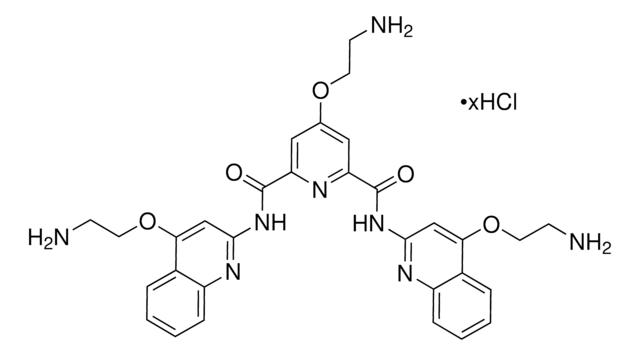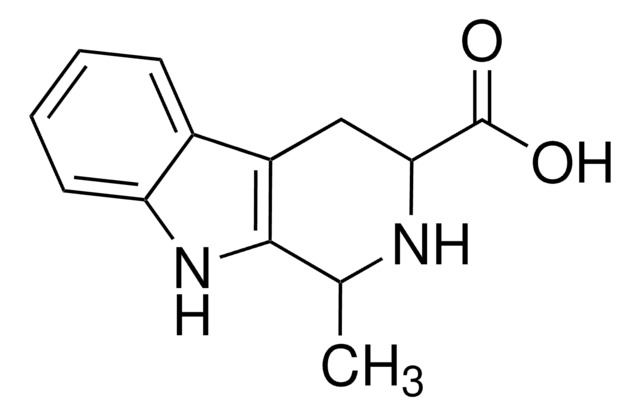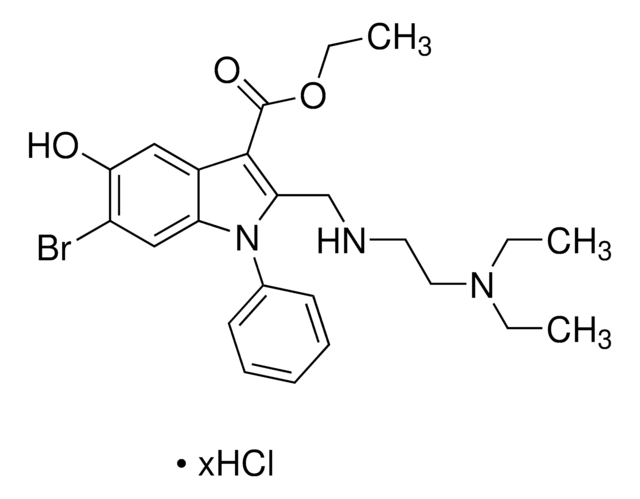Kluczowe dokumenty
SML2274
DDR1-IN-1
≥98% (HPLC)
Synonim(y):
4-((4-Ethylpiperazin-1-yl)methyl)-N-(4-methyl-3-(2-oxoindolin-5-yloxy)phenyl)-3-(trifluoromethyl)benzamide, N-[3-[(2,3-Dihydro-2-oxo-1H-indol-5-yl)oxy]-4-methylphenyl]-4-[(4-ethyl-1-piperazinyl)methyl]-3-(trifluoromethyl)benzamide
About This Item
Polecane produkty
Próba
≥98% (HPLC)
Formularz
powder
kolor
white to beige
rozpuszczalność
DMSO: 2 mg/mL, clear
temp. przechowywania
2-8°C
ciąg SMILES
CC(C=CC(NC(C1=CC(C(F)(F)F)=C(CN2CCN(CC)CC2)C=C1)=O)=C3)=C3OC4=CC(CC(N5)=O)=C5C=C4
InChI
1S/C30H31F3N4O3/c1-3-36-10-12-37(13-11-36)18-21-6-5-20(15-25(21)30(31,32)33)29(39)34-23-7-4-19(2)27(17-23)40-24-8-9-26-22(14-24)16-28(38)35-26/h4-9,14-15,17H,3,10-13,16,18H2,1-2H3,(H,34,39)(H,35,38)
Klucz InChI
AOZPVMOOEJAZGK-UHFFFAOYSA-N
Działania biochem./fizjol.
Kod klasy składowania
11 - Combustible Solids
Klasa zagrożenia wodnego (WGK)
WGK 3
Temperatura zapłonu (°F)
Not applicable
Temperatura zapłonu (°C)
Not applicable
Wybierz jedną z najnowszych wersji:
Certyfikaty analizy (CoA)
It looks like we've run into a problem, but you can still download Certificates of Analysis from our Dokumenty section.
Proszę o kontakt, jeśli potrzebna jest pomoc Obsługa Klienta
Masz już ten produkt?
Dokumenty związane z niedawno zakupionymi produktami zostały zamieszczone w Bibliotece dokumentów.
Nasz zespół naukowców ma doświadczenie we wszystkich obszarach badań, w tym w naukach przyrodniczych, materiałoznawstwie, syntezie chemicznej, chromatografii, analityce i wielu innych dziedzinach.
Skontaktuj się z zespołem ds. pomocy technicznej


![1,2,3,4-Tetrahydro-9H-pyrido[3,4-b]indole 98%](/deepweb/assets/sigmaaldrich/product/structures/181/460/3d58bc34-1b5c-4295-bbac-3b52085670e8/640/3d58bc34-1b5c-4295-bbac-3b52085670e8.png)





